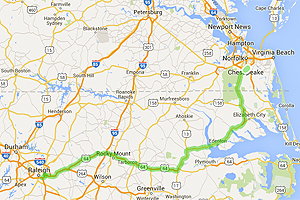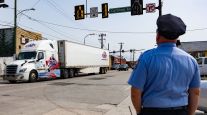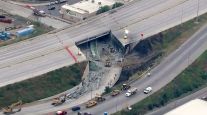New $1 Billion, 213-Mile Interstate Planned to Connect Norfolk and Raleigh

A new $1 billion interstate highway planned to connect Norfolk, Virginia, and Raleigh, North Carolina, will open a high-speed unobstructed route between a Virginia port and the Research Triangle.
The road, to be called Interstate 87, could take as long as two decades to complete. It has the support of elected officials, business leaders and agencies in Virginia and North Carolina, including both highway departments, chambers of commerce and all four senators.
“This is one of those things whose time has long since come,” said Joe Milazzo, executive director of the Regional Transportation Alliance, a business coalition in Raleigh.
Last year, Congress authorized the future interstate, which will be about 213 miles long. In May, the American Association of State Highway and Transportation Officials approved the I-87 designation.
In North Carolina, the highway will follow U.S. 64 east from Raleigh to Williamston, continue on U.S. 17 near Elizabeth City and up into Virginia. There, it will join Interstates 64 and 464 to Norfolk and the port facilities.
“We see I-87 as a means of transportation to open Hampton Roads to more efficient and more effective business,” said Bryan Stephens, president and CEO of the Hampton Roads Chamber of Commerce.
The route will open a needed avenue for freight going to the southwest, said Cathie Vick, chief public affairs officer for the Port of Virginia.
The highway is not funded and has no timeline for construction, said Jerry Jennings, an engineer for the North Carolina Department of Transportation. No study has been done on the interstate’s economic effects.
The entire project, which will be built in sections, is estimated to cost $1 billion, Jennings said. The federal government pays 90% of interstate construction, according to the Federal Highway Administration.
Studies will be conducted to determine construction needs and costs to convert U.S. 17 into an interstate. The many stoplights and connecting driveways on U.S. 17 would be gone.
Many sections of the road would need interchanges and possibly new bridges, among other improvements. Some stretches of U.S. 17 around Elizabeth City, Edenton and Windsor already meet interstate standards, Jennings said.
U.S. 64 between Williamston and Raleigh already has unobstructed access, wide rights of way and a 70 mph speed limit.
Dominion Boulevard in Chesapeake, which is in the midst of a $345 million widening due for completion next year, would become part of the new interstate, according to maps of the project. Dominion has long been a traffic bottleneck and a stopping point for business coming to North Carolina, said Wayne Harris, economic developer for Pasquotank County and Elizabeth City.
One of the first questions business investors tend to ask about a region is the distance to the nearest interstate, Harris said. The new highway would place less prosperous eastern North Carolina cities such as Elizabeth City and Edenton close to a major trucking corridor. The primary reason many eastern North Carolina counties are among the poorest in the state is the lack of a major highway, Harris said.
“This kind of swings the pendulum for Elizabeth City,” he said.
The number 87 was selected largely because the southern end of the road is in Raleigh between I-85 and I-95, Milazzo said.
The number also is tied to four historic years, he said. The colony of Sir Walter Raleigh was lost on Roanoke Island in 1587. James Madison’s 1787 Virginia Plan helped established the nation’s form of government. North Carolina State University was founded in 1887. Norfolk’s tallest building, Dominion Tower, was built in 1987.
The highway opens a better route between two prosperous mid-Atlantic states, Milazzo said.
“We’re very excited about the potential,” he said.




